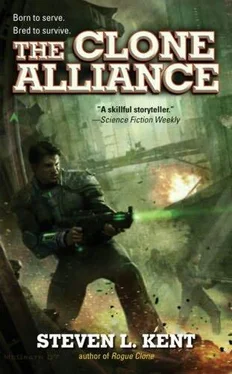Steven Kent - The Clone Alliance
Здесь есть возможность читать онлайн «Steven Kent - The Clone Alliance» весь текст электронной книги совершенно бесплатно (целиком полную версию без сокращений). В некоторых случаях можно слушать аудио, скачать через торрент в формате fb2 и присутствует краткое содержание. Жанр: Боевая фантастика, на английском языке. Описание произведения, (предисловие) а так же отзывы посетителей доступны на портале библиотеки ЛибКат.
- Название:The Clone Alliance
- Автор:
- Жанр:
- Год:неизвестен
- ISBN:нет данных
- Рейтинг книги:4 / 5. Голосов: 1
-
Избранное:Добавить в избранное
- Отзывы:
-
Ваша оценка:
- 80
- 1
- 2
- 3
- 4
- 5
The Clone Alliance: краткое содержание, описание и аннотация
Предлагаем к чтению аннотацию, описание, краткое содержание или предисловие (зависит от того, что написал сам автор книги «The Clone Alliance»). Если вы не нашли необходимую информацию о книге — напишите в комментариях, мы постараемся отыскать её.
Rogue clone Wayson Harris is stranded on a frontier planet-until a rebel offensive puts him back in the uniform of a U.A. Marine, once again leading a strike against the enemy. But the rebels have a powerful ally no one could have imagined.
The Clone Alliance — читать онлайн бесплатно полную книгу (весь текст) целиком
Ниже представлен текст книги, разбитый по страницам. Система сохранения места последней прочитанной страницы, позволяет с удобством читать онлайн бесплатно книгу «The Clone Alliance», без необходимости каждый раз заново искать на чём Вы остановились. Поставьте закладку, и сможете в любой момент перейти на страницу, на которой закончили чтение.
Интервал:
Закладка:
The final computer sat in the command station. That computer lifted information from the other five and organized it. On working ships, you would find groups of sailors clustered around each of these stations. Looking into the viewport of this wreck as we flew by, I saw nothing but darkness.
We dropped down the front edge of the ship. In space, of course, down is a relative thing. With no gravity determining what was up and what was down, I set my bearings by focusing on the battleship. We had just flown across its top side, and now we dropped down to examine its underbelly.
“What happened here?” Illych asked.
An enormous gash ran half the length of the ship. It almost looked as if some giant had grabbed the battleship by its wings, stabbed a knife into its underside, then slashed it across its belly.
“Shit. Someone specked them over bad,” I said.
“Yes, sir,” Illych said.
Illych’s voice had an offended tone to it. It took me a moment to decipher what might have bothered him. As I thought about it, I realized I had never heard Illych swear. None of the Special Operations clones did. They might slip up behind you and slit your throat, but they would not use bad language. Admirable…very specking admirable.
As we dropped under the battleship, its keel extended over us like a pitch-black sky. The breach across it looked like a gigantic crater. Four of the SEALs played their lights across it exposing a forty-foot-wide gash through which a careful pilot might successfully fly a small ship. From the look of things, the outer shell around these wounds had simply melted away. Bubbles, some popped and some whole, pocked the blackened edges of the gash.
As we flew toward the opening, one of the SEALs shined his light directly into it, illuminating the ship’s skeletal girders. The light uncovered torn wires and something that I first thought might be a ladder and later realized was the aluminum framing between the ceiling of one deck and the floor of the next. The gash through the hull extended up three decks of the ship.
So this is what it’s like when you die out in space, I thought to myself. “There’s our open door,” was what I said. I steered the sled into the gash.
Sitting in an enclosed spaceship, you develop misconceptions about how things work in space. In a ship, you get the feeling that you can simply cut the gas and coast to a stop. I always envisioned pilots stepping on the brakes to stop their ships the way I would in a car. When we studied space combat in boot camp, we trained in smaller vehicles than this sled; but those vehicles had armor plating to shield their works. I never appreciated everything that went into changing direction and coming to a stop.
On this sled, with its wide-open design, I saw how twenty different booster engines worked in concert to change our speed and direction as we flew. Before I could come to a stop, engines had to provide counterthrust to stop my forward momentum. A set of thrusters on the bottom of the sled fired forward. As we rose into that gash, several engines burst on and off as I fine-tuned the ascent to avoid jagged edges and debris.
“Stop!” one of the SEALs shouted.
The sled did not stop on a dime, but it stopped quickly enough. “You’re not going to believe this, but I’m picking up security sensors,” the SEAL said.
“Active sensors?” Illych asked.
“That’s what I’m reading,” the SEAL responded. “They’re ancient, and I mean ancient…electronic motion-tracking sensors.”
“This ship is fifty years old,” Illych reminded the other SEAL.
At first I thought their reconnaissance armor contained technology that my combat armor lacked. All six SEALs stood huddled together staring straight up like bird-watchers trying to spot some rare species. Then I saw that they each held some sort of remote in their hands.
“Think we can jam it?” Illych asked.
“No problem,” that first SEAL replied. He held up the remote, something the size of a deck of cards with a row of buttons across it. He pressed one of the buttons. The button lit up red.
“Nice spotting,” Illych said. He turned to me. “You won’t have one of these stealth kits, sir.” He held up his remote for me to see. “Stay with me. As long as you are with one of us, the sensors won’t detect you.”
I nodded. “Is it safe to enter?” I asked.
“Yes, sir, Colonel,” that first SEAL said. “If you have one of these stealth kits, you can skip rope, pass gas, and cook cheeseburgers all at the same time, and the sensors won’t spot you.”
I restarted the sled. Rising through the wreckage, we passed two decks and stopped on the third. We rode past hallways so dark that they seemed to digest the SEALs’ spotlight beams. I did not have a spotlight. I had to rely on the night-for-day lens built into the visor of my helmet. In that blue-white version of the world that the night-for-day lens showed me, I saw flat black spaces instead of corridors. Night-for-day vision let you see in the dark, but it took away your depth perception.
Whatever Porter and his fleet had fired at the battleship took out every system. I saw no signs of working electricity. The artificial gravity was out. The life support was down.
“You seen anybody?” one of the SEALs asked all of us over an open interLink frequency. “I expected dead sailors floating around.”
“Think they evacuated the ship?” Illych asked me.
“Don’t count on it,” I said. “Anybody in this area would have gotten flushed out.” I had seen big ships explode. Once something pierces the hull, the pressure of the ship’s atmosphere flushes bodies, furniture, and other debris out of the gap until the pressure equalizes.
“So you think we’ll find bodies?” Illych asked.
“Sure we will, over a thousand of them if this battleship had a full crew. You and your boys aren’t squeamish?” I asked. I knew they were not, but I could hardly pass as a credible officer if I did not take a cheap shot every now and then.
After landing the sled on the first solid stretch of floor I found, I told the SEALs to divide up.
“What did you have in mind, sir?” Illych asked.
I sent five of the SEALs to the bridge to examine the navigation computer and whatever charts they could find. There was no need to tell them what to do if they found live enemies. These clones had tactics hardwired into their brains. They knew what to do in these situations as instinctively as they knew what to do in a latrine.
“Why don’t you come with me to the engineering section?” I asked Illych. The smart display in my visor read the SEALs’ virtual dog tags, allowing me to tell them apart. I’d had enough trouble telling them apart before they put on their identical armor.
Illych saluted and followed.
Before leaving the Kamehameha , we preloaded the general deck map of a GCF battleship into our helmet computers. The maps were based on fifty-year-old information, but they proved reliable. I had no doubt that the other team would find the navigation computer in the bridge on the top deck by following the map. Whether or not they could remove the data storage from the navigation computer was a different issue. For that matter, I did not know how I would remove the data storage unit from the broadcast computer in the engineering section.
What we saw on this trip was almost as important as what we stole. We had video-recording devices in our helmets. Anything we saw would be stored on a chip. I wanted to explore as much of the ship as possible so that I could create a video record to show Yoshi Yamashiro and his engineers. The Japanese renovated these old ships when they partnered with the Mogats.
I suspected that something had changed since the Separatist alliance fell apart. When the Mogat Fleet attacked Earth, Unified Authority ships had more than enough firepower to sink its ships one-on-one. Now a handful of Mogat ships had routed the Outer Perseus Fleet. What changed?
Читать дальшеИнтервал:
Закладка:
Похожие книги на «The Clone Alliance»
Представляем Вашему вниманию похожие книги на «The Clone Alliance» списком для выбора. Мы отобрали схожую по названию и смыслу литературу в надежде предоставить читателям больше вариантов отыскать новые, интересные, ещё непрочитанные произведения.
Обсуждение, отзывы о книге «The Clone Alliance» и просто собственные мнения читателей. Оставьте ваши комментарии, напишите, что Вы думаете о произведении, его смысле или главных героях. Укажите что конкретно понравилось, а что нет, и почему Вы так считаете.











